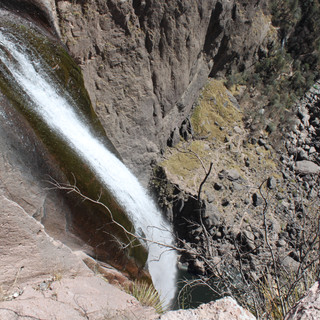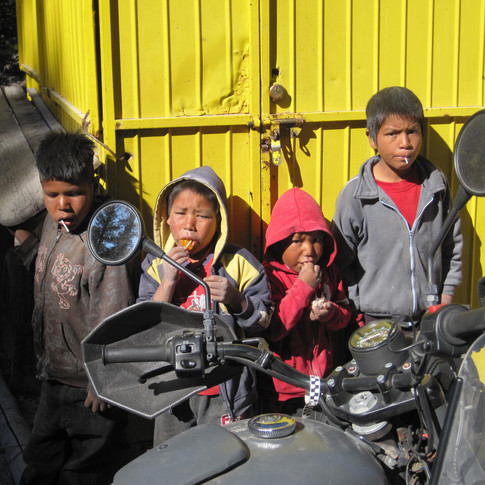The Copper Canyon
- Yvonne O'Connor
- Jan 25, 2018
- 4 min read
Before we left town, Fred advised us on several routes and points of interest for the next stage of the journey. Our immediate destination was the Copper Canyon but the huge swath of sparsely populated land between there and Mexico City was largely unknown to us. We decided to stay in the center of the country and avoid the coasts and tourist areas. We drove southwest to La Junta where we met a friend of Fred’s who was also a motorcycle enthusiast. He and his wife invited us to their home and we enjoyed it so much we decided we’d all to drive to Creel together on the weekend. In the meantime we had the Basaseachi waterfall to visit.
Click to enlarge photos
Basaseachi town itself was very small but the falls were close by. At 246 meters it is the second highest waterfall in Mexico. We checked-in to a fairly new, i.e. unfinished, hotel and got to practice our off-road driving skills in the ‘parking lot’. Alas, it was the dry season. Still, the setting was spectacular. Dark green mountains with deep canyons surrounded us, and not another soul around. We climbed over the flat rocks where the two streams merged and leaned over the side to watch the water flow over the edge and down the canyon wall. A faint spray hit our faces; it was a long way down.
Back at the dusty parking lot, the local cat was busy in our absence. The bloody thing peed on the cover of my sidecar and I didn’t notice until it spilled all over my pants. I don’t think a cardboard pine tree on my windshield is going to be able to cope with this one. After a surprisingly good meal in the only restaurant in town (it was empty), we turned in. Overnight the weather turned so cold, the motel pipes froze so no water, at all, the next morning. Here we go again, more layers of clothing.
We spent a busy week in the small town of Creel. As well as a railroad depot on the Chihuahua-Pacific Line, it’s the jumping off point for the Copper Canyon. The road from La Junta climbed higher and higher until the yellow grasses were replaced with green pines. It must be packed with tourists during the high season but again we stood out on the streets. We ran out of restaurants early on and the local ‘Super was limited. However, the street carts served great tamales and the man with the black-and-white cow painted truck was there every day selling Mennonite cheese, dried beef and honey. The town is at 2300+ meters so the nighttime temperatures were cooler and the Tarahumara Indians were wrapped in colorful layers. Their children could be seen standing at restaurant windows at night, watching the flickering television screens inside, like little Mexican match girls.
At the Cusarare falls, more of the same kids followed us while four or five of them stayed behind ‘to guard’ the bike. For a small fee, naturally. Their mothers sat silently under makeshift straw canopies, or on flat rocks, weaving baskets out of reeds. Again, the falls were lacking an abundance of water but worth the trip all the same. The only thing missing was Tarzan. The 3 km ride up there was our first off-road experience, with rocks and dips and even water crossings, albeit it shallow ones. Poor Pferdi rattled and shook and I with my jaw clenched expected his undercarriage to be ripped apart at any minute. But we survived.
You could spend weeks here and not explore it all. We visited Lake Arareko, Mission San Ignacio and then on to the strange rock formations of the Bisabirachi Valley.
On Saturday morning we drove down to the Copper Canyon. The view at El Divisadero was dizzying. The Tarahumara women displaying their crafts were a riot of color and over the railing the ground disappeared in a sheer drop. I got sentimental watching a young mother playing with her baby, both enjoying each other’s company to the exclusion of all else. Later, with a new minder, the baby now lay on its back playing with a large plastic bag. ‘No Toys-R-Us kids around here.
We ate lunch at the small market up high on the railway line. All was quiet except for the chickens pecking about the tracks. Local women were cooking on small grills perched on top of metal drums. Nothing goes to waste around here. We ate Gorditas, blue corn tortillas stuffed with cheese and meat, hot off the grill. They were delicious, especially washed-down with bottles of peppery, Mexican Coca Cola. When a small tour bus arrived the Mennonites were among the visitors. There is a large community of them in the state of Chihuahua. The women still wear their conservative black frocks and cloth caps, black or white, depending on their marital status. The men, as usual, are less restricted and seem to be comfortable in checked shirts and denim dungarees. It is a strange mixture of cultures, this state: old Germany, Spain and a timeless Indian tribe.
At the end of the week, it was time to move on. With no coffee in the hotels, or even boiling water to add to a spoon of Nescafe, and no shops selling it to go, we had no choice. If this continues, we just might have to mount a small percolator on the tank. Biker Baristas. It has a nice ring to it.












































Comments